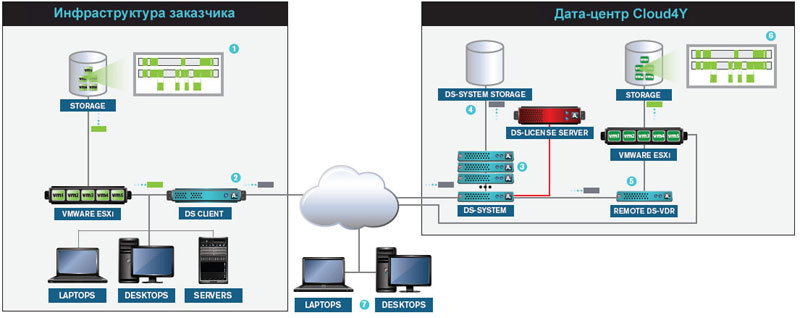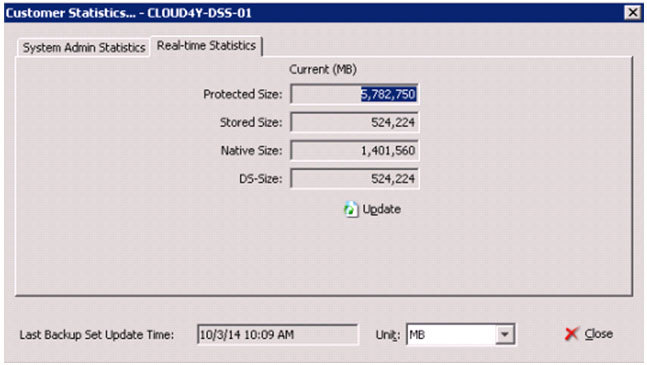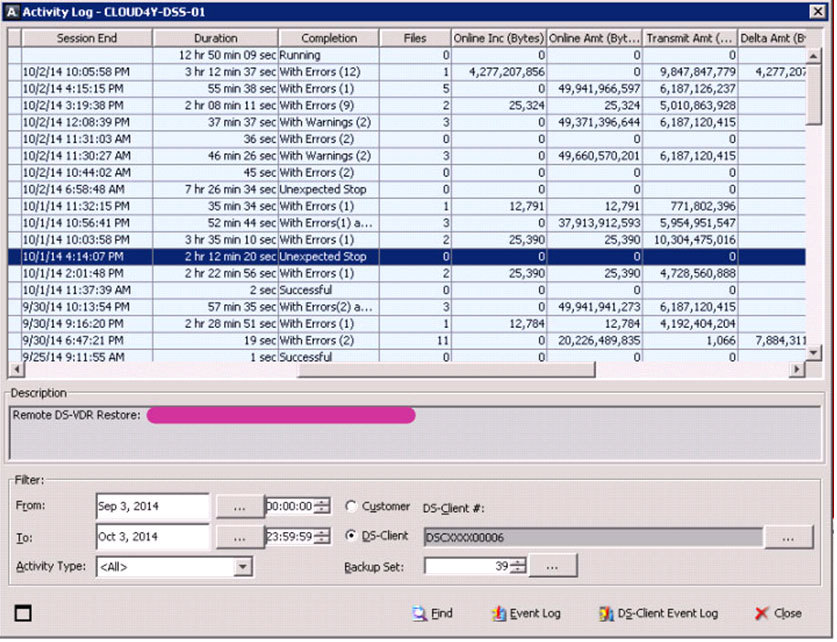How we backed up the client’s IT infrastructure in Donetsk
Backup for the customer is a usual service, but this case is distinguished by the fact that the customer, RBC Ukrinvest and its infrastructure are located in Donetsk. It probably does not make sense to talk about the constant bombing, shelling of buildings, etc., I think that everything is up to date. But it was these circumstances that made the client think about the need for a full backup of his IT infrastructure in the cloud.

We deployed all our resources remotely.
In this post I will talk about the technical side of the project, about the problems that arose and the results obtained.
The main goal is to ensure the safety of IT infrastructure and critical corporate information in case of failure of the server customer and, accordingly, equipment.
Note: unfortunately, I do not have the right to publish a complete list of equipment and customer services in connection with the signing of a non-disclosure agreement. Nevertheless, it can be said that the customer’s IT infrastructure corresponds to a medium-sized company: first of all, the MS Exchange mail server, the infrastructure of virtual servers critical for the company.
The main task that confronted us was to provide continuous backup of IT infrastructure and critical corporate customer information to our cloud. In the event of failure of their own equipment, the customer should be able to work in a similar IT infrastructure in the Cloud4Y cloud. The main limitation is the compatibility of virtual environments, on the basis of which the customer’s virtual server infrastructures are synchronized with Cloud4Y’s cloud infrastructure. Since we and the customer had virtualization environments that were compatible, we decided to use Asigra-VDR-based solutions. For a general view of the amount of synchronized virtual resources: the total amount of data was 1.5 TB.
All work was carried out remotely in conjunction with the technical specialists of the customer. Asigra Backup was chosen as the solution with incremental backup, compression and encryption technology. The Asigra Remote DS-VDR Incremental Restore operation scheme was used, which allowed transferring only changed blocks of virtual machines.
The Asigra Remote DS-VDR Incremental Restore operation scheme is as follows:

1) The DS-client (Asigra agent) receives only modified blocks of virtual machines.
2) DS-client deduplicates, compresses and encrypts the changed blocks and sends them to DS-systems via WAN.
3) DS-system receives files from DS-Client.
4) The DS-system stores files in the backup storage in a compressed, encrypted, and deduplicated form.
5) Remote VDR receives the changed blocks from the DS-system, decrypts, unpacks and updates the changed blocks of the backup virtual machines in their original format.
6) Remote DS-VDR performs incremental recovery from virtual machines in standby mode of the ESXi server by writing the changed blocks in the corresponding disk partition.
7) When the customer encounters equipment failure, he will be able to access the backup IT infrastructure and corporate data that are deployed in Cloud4Y.
I would like to note a high degree of compression - with a volume of 1.5TB of useful data, the archive amounted to about 450 GB.

Top 3 specific risks of Donetsk due to military operations: the threat of shells entering the room, power outages, destruction of cable infrastructure. Other risks are typical: seizure of servers in case of violation of the law, transfer of the premises to state ownership - this problem can be generalized as an instant physical destruction of the data center.
The most common problem of our client was falling communication channels. The customer’s Internet constantly disappeared in the office due to shelling of nearby buildings. In addition, the electricity was periodically turned off, while the UPS lasted only 8 hours. For these reasons, it took 3 days to synchronize the customer’s IT infrastructure with the cloud.

The key to the success of the task, namely: "To ensure the efficiency of the client, all of his critical resources as soon as possible" - was the preparatory stage.
With the help of my colleagues from Cloud4Y, Asigra DS-Client Agent was introduced into the customer’s area of responsibility, which allows implementing the technology of incremental backup of client’s virtual machines. We did not particularly go into the composition of customer data. The intuitive interface of the Asigra DS-Client Agent, after a demo consultation with a client’s specialist, made it possible to quickly back up all critical client virtual servers.
An important component for starting a successful operation is the first backup cycle of a virtual resource, which must be completed successfully. Due to the fact that in the city where the client is located, military operations are constantly ongoing (communication is interrupted, periodically there is no power supply), this stage was completed in several approaches. The efficiency of data deduplication and compression implemented by Asigra allowed us to force the first backup cycle and switch to incremental mode. For reference, you can report that the compression and deduplication efficiency reached from 1: 4 to 1:10 (i.e., the actual transferred volume, even at the first stage of a full backup, was several times less than the original infrastructure), which also allowed us not to overload the external channels client communications (located at a great distance from the cloud),
On the Cloud4Y side, Asigra VDR Agents were deployed in parallel, which automatically restored the customer’s virtual machines as soon as the next backup cycle ended.
Summarizing the practical side of backup: a copy of virtual resources in the Cloud4Y cloud deployed with a maximum of 3 hours behind and was theoretically always promptly ready for work. But this is “theoretically” also a practical side, which requires careful preparation on the side of the cloud provider.
For our part, we used the VMWare vCloudDirector cloud infrastructure management interface. The main practical advantage of this platform is the freedom to implement isolated networks both within the framework of the infrastructure of the virtual Client Data Center (VDC) and within the framework of the vApp infrastructure (virtual infrastructure).
After the next cycle of automatic recovery, virtual machines “come” to us in the configuration and composition, which is directly located at the customer's place. That is, the first recovery cycle prescribes the network interfaces of virtual machines as those originally located at the customer. To reduce the time of the subsequent emergency upgrade of the customer’s infrastructure, it is necessary to prepare virtual isolated networks in vCloudDirector in advance and register the actual addressing used by the client in them. This step was also done in dialogue with the customer’s technical specialists.
The final touches on preparing to work a copy of the virtual infrastructure are preparing a virtual gateway that implements client virtual machines access in the Cloud4Y cloud “outside”, as well as realizes firewalling of the client’s closed infrastructure.
1. In the cloud is always a copy of the customer’s infrastructure with a 3-hour delay (max).
2. Disaster recovery of the client’s infrastructure occurs by simply launching its infrastructure in the Cloud (which the customer himself can do through the vCloudDirector interface of his virtual Data Center).
3. External client services are reconfigured by making changes to dns.
Subsequently, the client, using the same Asigra backup technologies, through his Asigra DS Client Agent, can always restore its infrastructure to its original or new location, if such a need arises.
As a result, the emergency work of the client in the event of extremely adverse events (up to the complete destruction of its infrastructure) is ensured.
Thank you for your attention, we will be happy to answer your questions.


We deployed all our resources remotely.
In this post I will talk about the technical side of the project, about the problems that arose and the results obtained.
goal
The main goal is to ensure the safety of IT infrastructure and critical corporate information in case of failure of the server customer and, accordingly, equipment.
Note: unfortunately, I do not have the right to publish a complete list of equipment and customer services in connection with the signing of a non-disclosure agreement. Nevertheless, it can be said that the customer’s IT infrastructure corresponds to a medium-sized company: first of all, the MS Exchange mail server, the infrastructure of virtual servers critical for the company.
Task
The main task that confronted us was to provide continuous backup of IT infrastructure and critical corporate customer information to our cloud. In the event of failure of their own equipment, the customer should be able to work in a similar IT infrastructure in the Cloud4Y cloud. The main limitation is the compatibility of virtual environments, on the basis of which the customer’s virtual server infrastructures are synchronized with Cloud4Y’s cloud infrastructure. Since we and the customer had virtualization environments that were compatible, we decided to use Asigra-VDR-based solutions. For a general view of the amount of synchronized virtual resources: the total amount of data was 1.5 TB.

Decision
All work was carried out remotely in conjunction with the technical specialists of the customer. Asigra Backup was chosen as the solution with incremental backup, compression and encryption technology. The Asigra Remote DS-VDR Incremental Restore operation scheme was used, which allowed transferring only changed blocks of virtual machines.
How it works
The Asigra Remote DS-VDR Incremental Restore operation scheme is as follows:

1) The DS-client (Asigra agent) receives only modified blocks of virtual machines.
2) DS-client deduplicates, compresses and encrypts the changed blocks and sends them to DS-systems via WAN.
3) DS-system receives files from DS-Client.
4) The DS-system stores files in the backup storage in a compressed, encrypted, and deduplicated form.
5) Remote VDR receives the changed blocks from the DS-system, decrypts, unpacks and updates the changed blocks of the backup virtual machines in their original format.
6) Remote DS-VDR performs incremental recovery from virtual machines in standby mode of the ESXi server by writing the changed blocks in the corresponding disk partition.
7) When the customer encounters equipment failure, he will be able to access the backup IT infrastructure and corporate data that are deployed in Cloud4Y.
I would like to note a high degree of compression - with a volume of 1.5TB of useful data, the archive amounted to about 450 GB.

Problems
Top 3 specific risks of Donetsk due to military operations: the threat of shells entering the room, power outages, destruction of cable infrastructure. Other risks are typical: seizure of servers in case of violation of the law, transfer of the premises to state ownership - this problem can be generalized as an instant physical destruction of the data center.
The most common problem of our client was falling communication channels. The customer’s Internet constantly disappeared in the office due to shelling of nearby buildings. In addition, the electricity was periodically turned off, while the UPS lasted only 8 hours. For these reasons, it took 3 days to synchronize the customer’s IT infrastructure with the cloud.

The key to the success of the task, namely: "To ensure the efficiency of the client, all of his critical resources as soon as possible" - was the preparatory stage.
With the help of my colleagues from Cloud4Y, Asigra DS-Client Agent was introduced into the customer’s area of responsibility, which allows implementing the technology of incremental backup of client’s virtual machines. We did not particularly go into the composition of customer data. The intuitive interface of the Asigra DS-Client Agent, after a demo consultation with a client’s specialist, made it possible to quickly back up all critical client virtual servers.
An important component for starting a successful operation is the first backup cycle of a virtual resource, which must be completed successfully. Due to the fact that in the city where the client is located, military operations are constantly ongoing (communication is interrupted, periodically there is no power supply), this stage was completed in several approaches. The efficiency of data deduplication and compression implemented by Asigra allowed us to force the first backup cycle and switch to incremental mode. For reference, you can report that the compression and deduplication efficiency reached from 1: 4 to 1:10 (i.e., the actual transferred volume, even at the first stage of a full backup, was several times less than the original infrastructure), which also allowed us not to overload the external channels client communications (located at a great distance from the cloud),
On the Cloud4Y side, Asigra VDR Agents were deployed in parallel, which automatically restored the customer’s virtual machines as soon as the next backup cycle ended.
Summarizing the practical side of backup: a copy of virtual resources in the Cloud4Y cloud deployed with a maximum of 3 hours behind and was theoretically always promptly ready for work. But this is “theoretically” also a practical side, which requires careful preparation on the side of the cloud provider.
For our part, we used the VMWare vCloudDirector cloud infrastructure management interface. The main practical advantage of this platform is the freedom to implement isolated networks both within the framework of the infrastructure of the virtual Client Data Center (VDC) and within the framework of the vApp infrastructure (virtual infrastructure).
After the next cycle of automatic recovery, virtual machines “come” to us in the configuration and composition, which is directly located at the customer's place. That is, the first recovery cycle prescribes the network interfaces of virtual machines as those originally located at the customer. To reduce the time of the subsequent emergency upgrade of the customer’s infrastructure, it is necessary to prepare virtual isolated networks in vCloudDirector in advance and register the actual addressing used by the client in them. This step was also done in dialogue with the customer’s technical specialists.
The final touches on preparing to work a copy of the virtual infrastructure are preparing a virtual gateway that implements client virtual machines access in the Cloud4Y cloud “outside”, as well as realizes firewalling of the client’s closed infrastructure.
Result
1. In the cloud is always a copy of the customer’s infrastructure with a 3-hour delay (max).
2. Disaster recovery of the client’s infrastructure occurs by simply launching its infrastructure in the Cloud (which the customer himself can do through the vCloudDirector interface of his virtual Data Center).
3. External client services are reconfigured by making changes to dns.
Subsequently, the client, using the same Asigra backup technologies, through his Asigra DS Client Agent, can always restore its infrastructure to its original or new location, if such a need arises.
As a result, the emergency work of the client in the event of extremely adverse events (up to the complete destruction of its infrastructure) is ensured.
Thank you for your attention, we will be happy to answer your questions.

